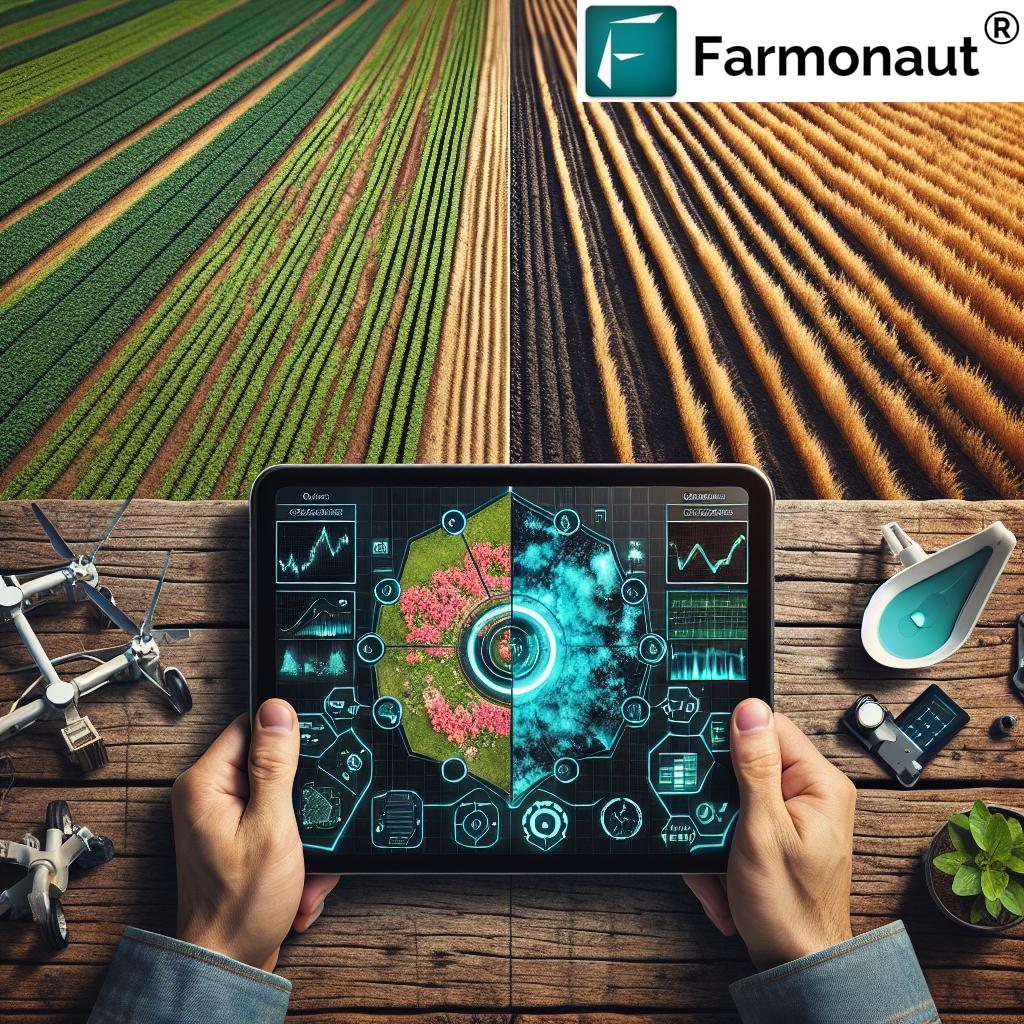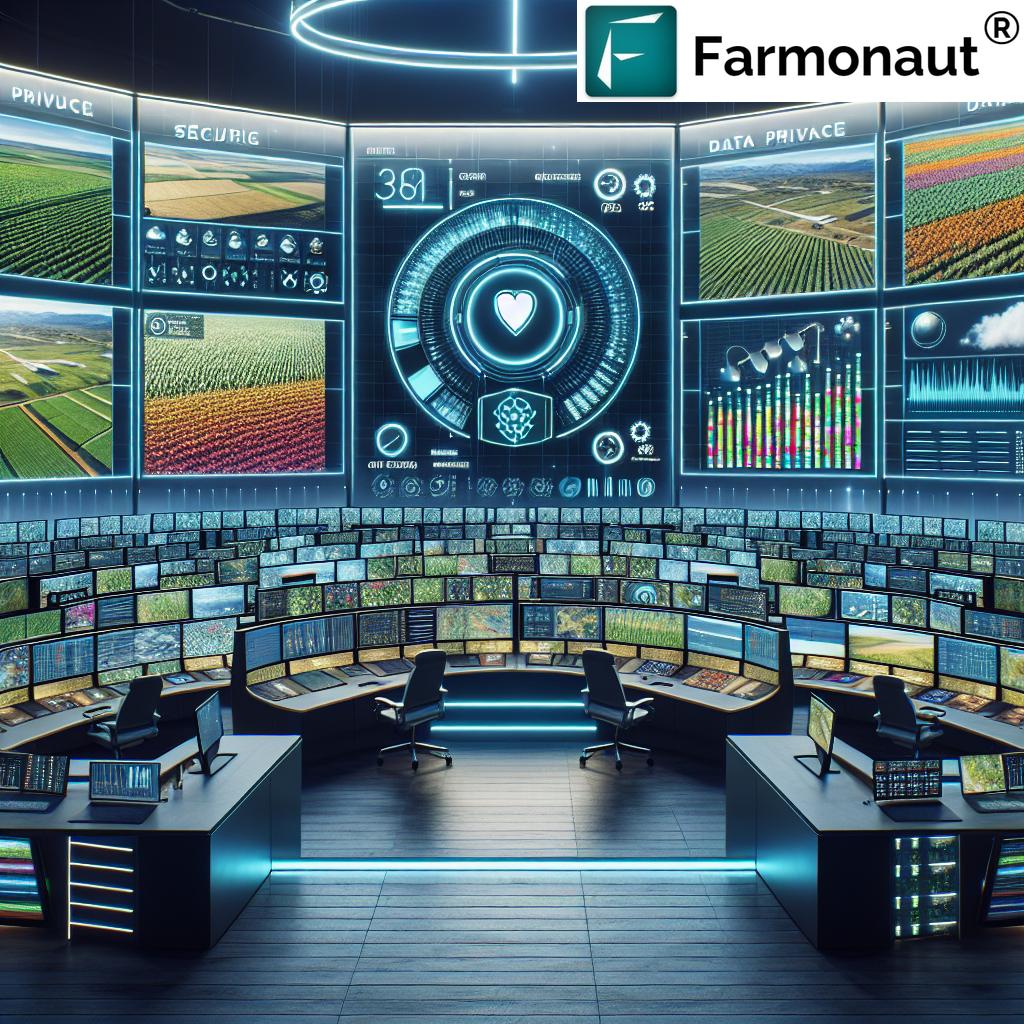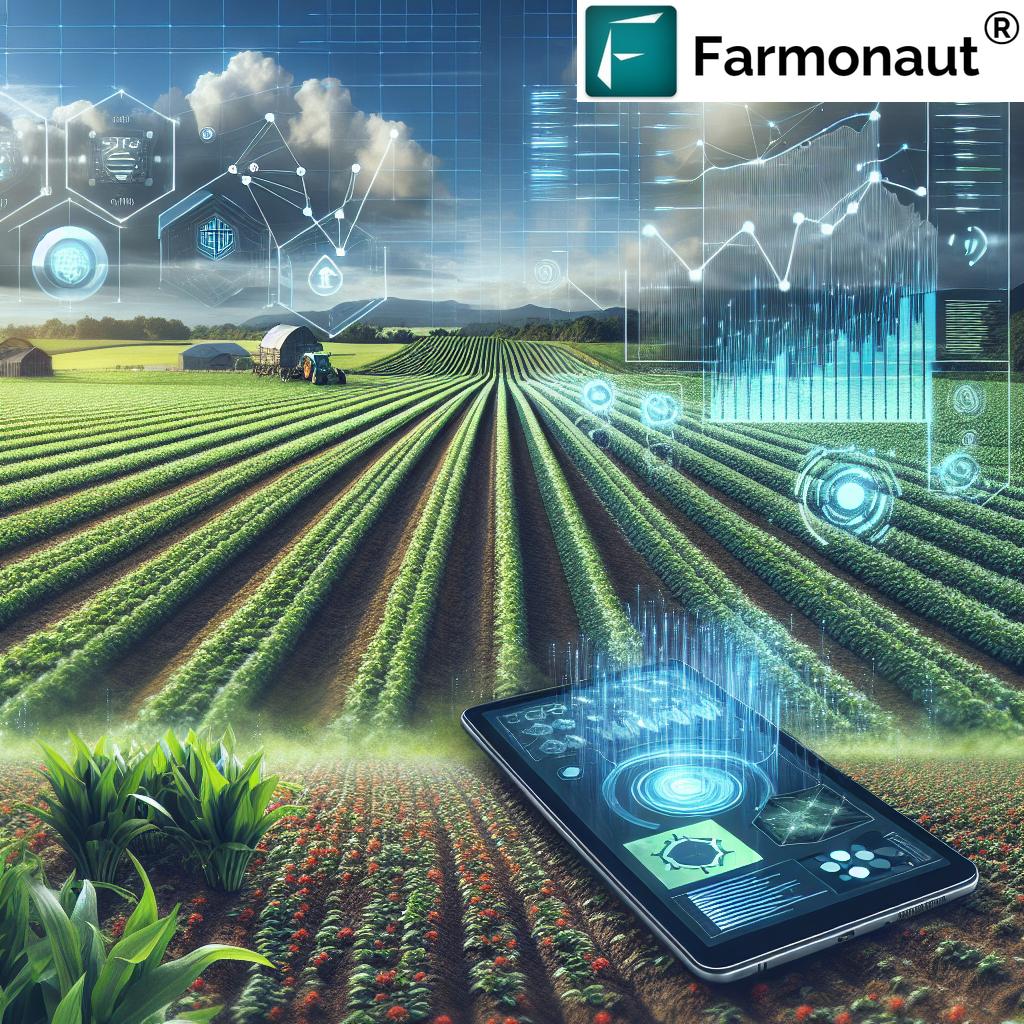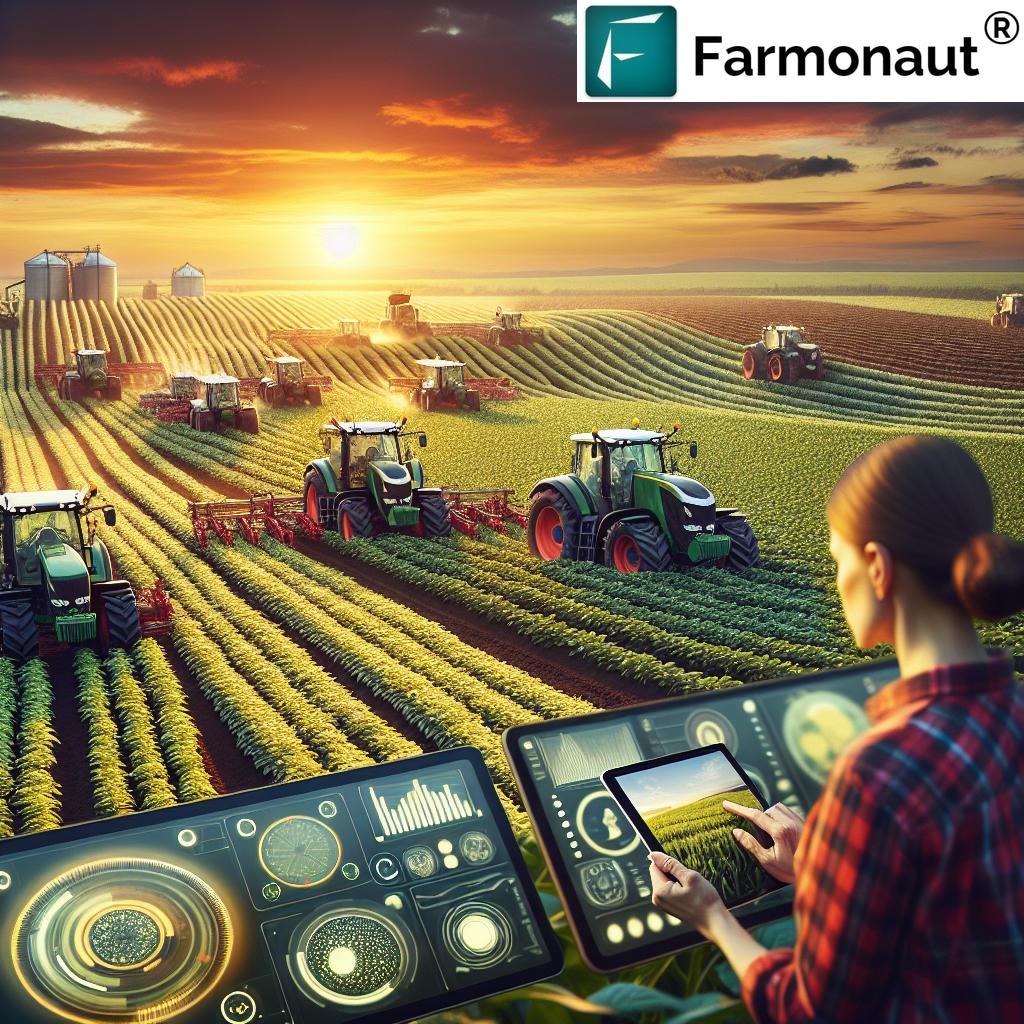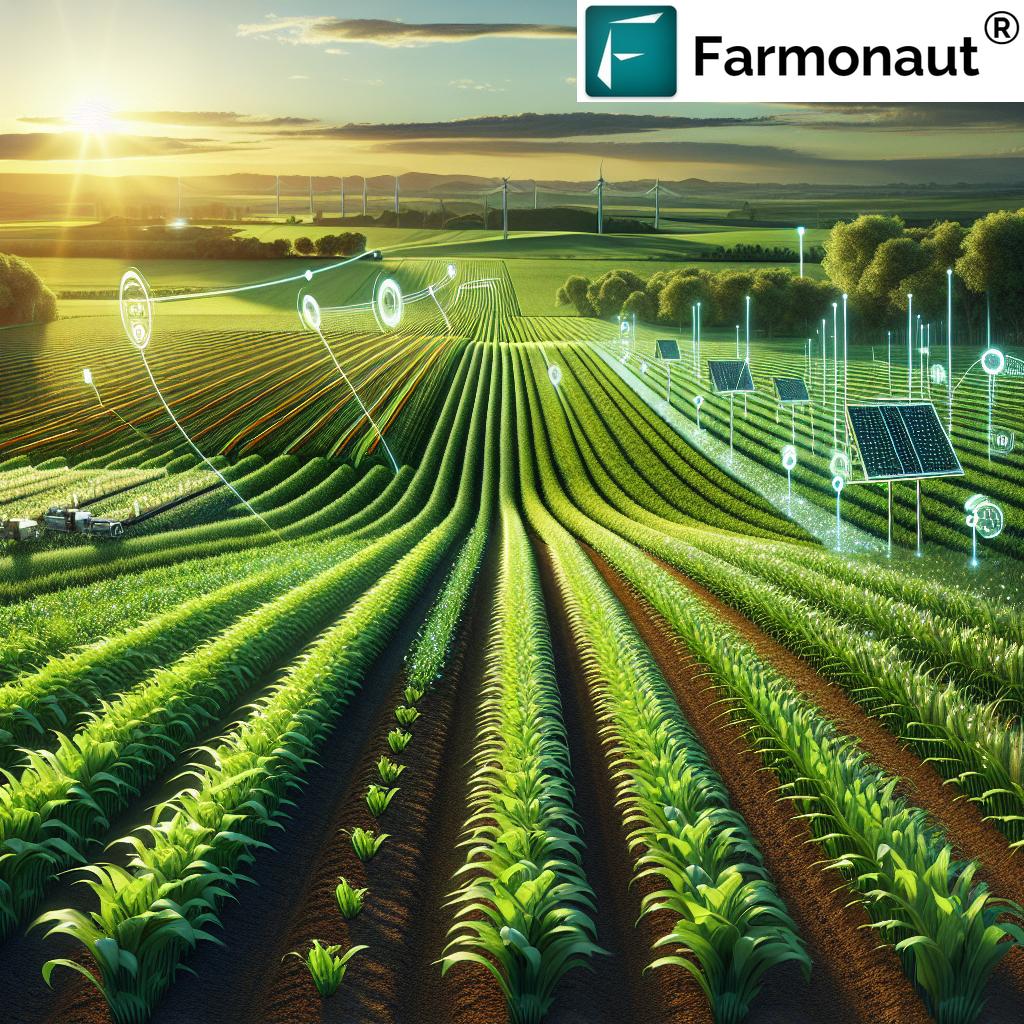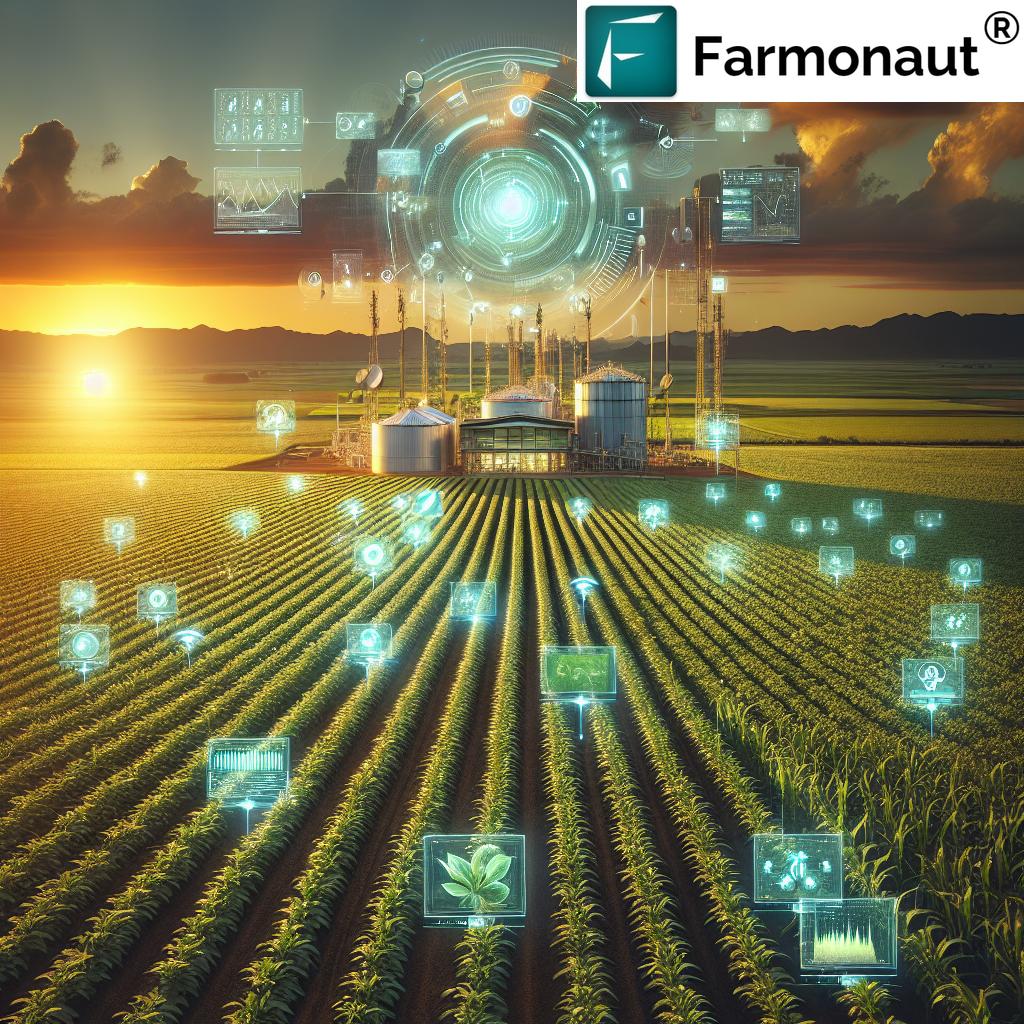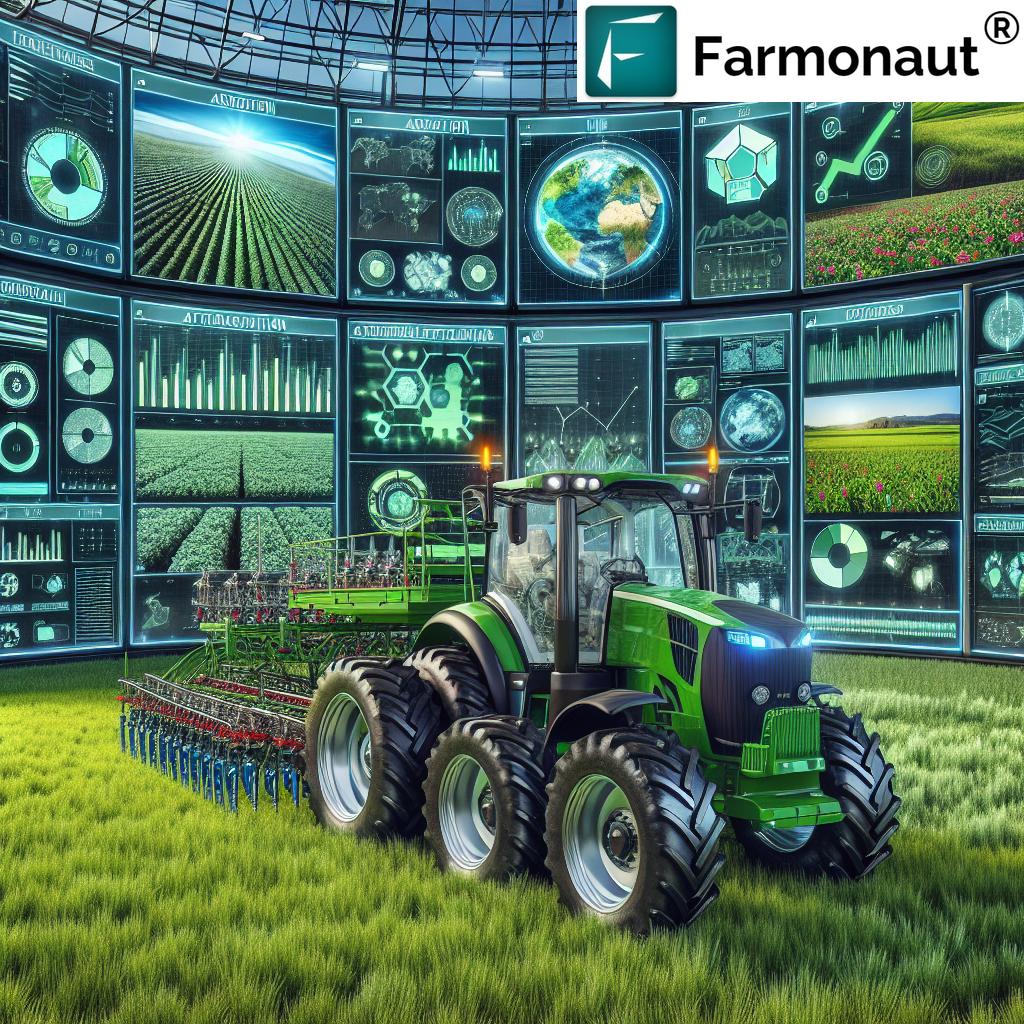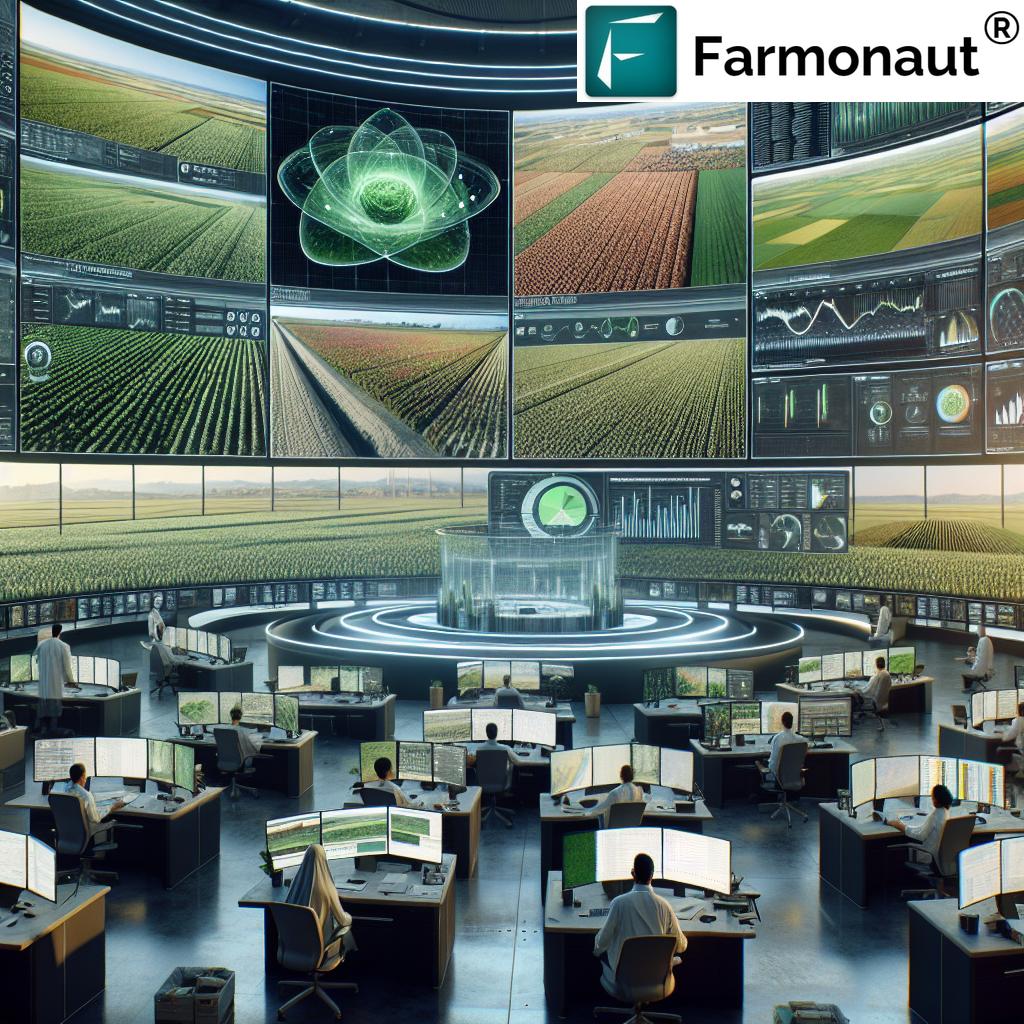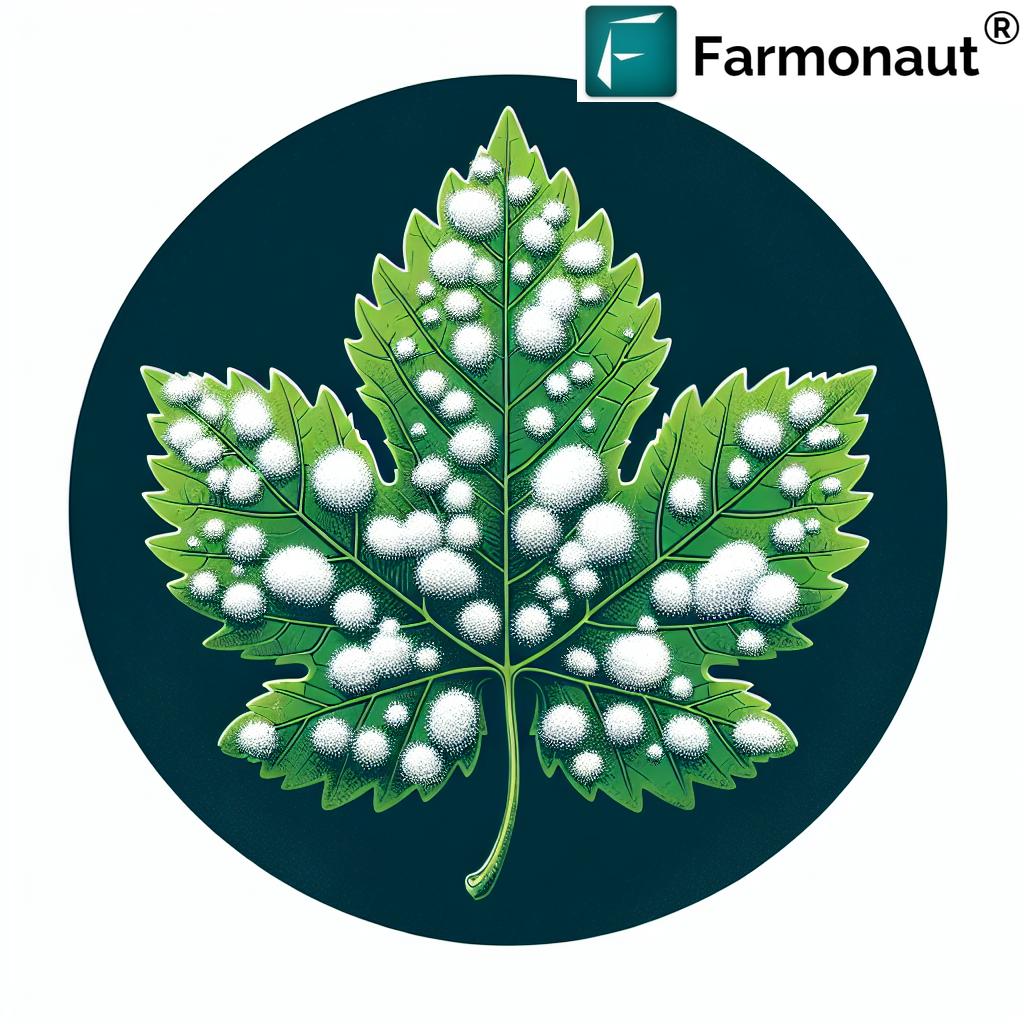Here’s a comprehensive blog post based on your requirements:
IoT in Cotton Farming: Revolutionizing Agricultural Practices for Sustainable Growth
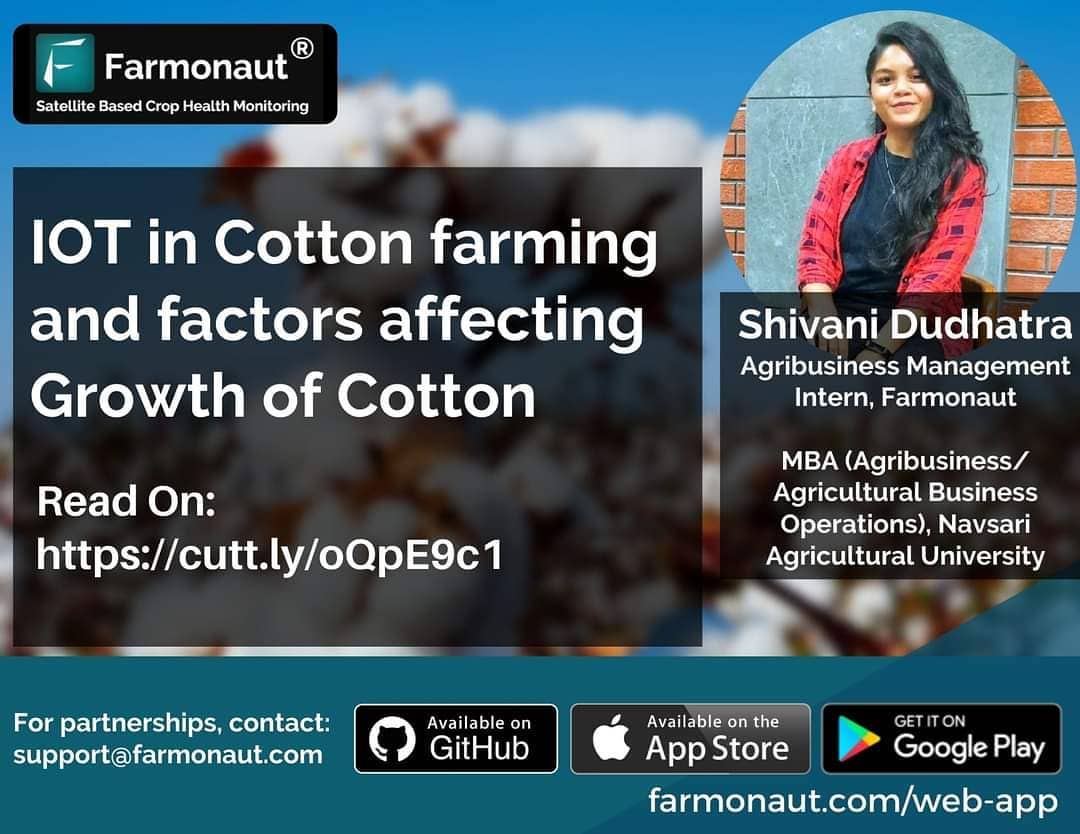
In today’s rapidly evolving agricultural landscape, the integration of Internet of Things (IoT) technology is transforming cotton farming practices. At Farmonaut, we’re excited to share insights from a groundbreaking report that delves into the intersection of IoT and cotton production. This comprehensive analysis, curated by Shivani Dudhatra, an MBA graduate from Navsari Agricultural University and Agribusiness Management Research Intern at Farmonaut, sheds light on how technology is becoming an integral part of farming culture.
Table of Contents
- Introduction to IoT in Cotton Farming
- Factors Affecting Cotton Production in India
- Technological Impact on U.S. Cotton Production
- Enhancing Cotton Farmer Sustainability
- Strategies to Improve Crop Yield
- Increasing Organic Carbon in Soil
- Farmonaut’s Role in Modern Agriculture
- FAQs
- Conclusion
1. Introduction to IoT in Cotton Farming
The Internet of Things (IoT) has emerged as a game-changer in the agricultural sector, particularly in cotton farming. IoT refers to the network of interconnected devices that collect and exchange data, providing farmers with real-time insights and automated solutions. In cotton farming, IoT applications range from smart irrigation systems to drone-based crop monitoring and automated harvesting equipment.
Key benefits of IoT in cotton farming include:
- Improved resource management
- Enhanced crop monitoring
- Precise pest and disease control
- Optimized harvesting schedules
- Data-driven decision-making
At Farmonaut, we’ve been at the forefront of integrating IoT solutions with satellite-based technologies to provide comprehensive farm management tools. Our platform combines the power of IoT with advanced satellite imagery to offer unparalleled insights into cotton crop health and growth patterns.
2. Factors Affecting Cotton Production in India
India, as one of the world’s largest cotton producers, faces unique challenges and opportunities in its cotton farming sector. Understanding these factors is crucial for implementing effective IoT solutions and improving overall productivity.
Climate and Weather Patterns
Cotton is highly sensitive to climate variations. In India, factors such as:
- Monsoon patterns
- Temperature fluctuations
- Drought conditions
significantly impact cotton production. IoT devices like weather stations and soil moisture sensors can provide real-time data to help farmers adapt to these conditions.
Soil Health
The quality of soil plays a crucial role in cotton yield. Factors affecting soil health include:
- Organic matter content
- pH levels
- Nutrient balance
- Soil structure
IoT-enabled soil testing kits and sensors can help farmers monitor these parameters continuously, allowing for timely interventions.
Pest and Disease Management
Cotton crops are susceptible to various pests and diseases. IoT solutions such as:
- Automated pest traps
- Image recognition systems for disease detection
- Precision spraying equipment
can significantly improve pest and disease management strategies.
Water Management
Efficient water use is critical in cotton farming. IoT-based irrigation systems can:
- Monitor soil moisture levels
- Automate irrigation schedules
- Reduce water wastage
This is particularly important in water-stressed regions of India.
Market Dynamics
Fluctuations in cotton prices and demand can affect production decisions. IoT platforms can provide:
- Real-time market data
- Price prediction models
- Supply chain optimization tools
These insights help farmers make informed decisions about planting and harvesting.
3. Technological Impact on U.S. Cotton Production
The United States, another major player in global cotton production, has been at the forefront of adopting IoT technologies in agriculture. The impact of these technologies on U.S. cotton production has been significant and multifaceted.
Precision Agriculture
IoT has enabled precision agriculture practices in U.S. cotton farms, including:
- GPS-guided planting and harvesting
- Variable rate application of inputs
- Yield mapping
These technologies have led to optimized resource use and increased productivity.
Data-Driven Decision Making
U.S. cotton farmers are leveraging big data analytics powered by IoT to:
- Analyze historical yield data
- Predict optimal planting times
- Forecast potential crop issues
This data-centric approach has significantly improved farm management strategies.
Automated Farm Equipment
The integration of IoT in farm machinery has revolutionized cotton farming operations:
- Self-driving tractors
- Automated cotton pickers
- Smart sprayers
These technologies have increased efficiency and reduced labor costs.
Remote Monitoring and Management
IoT enables U.S. cotton farmers to:
- Monitor crop conditions remotely
- Control irrigation systems from mobile devices
- Receive real-time alerts on potential issues
This level of remote management has improved response times and reduced the need for constant physical presence in the fields.
Sustainability Initiatives
IoT technologies are supporting sustainability efforts in U.S. cotton farming through:
- Reduced water usage
- Optimized pesticide and fertilizer application
- Improved soil health management
These initiatives are helping to reduce the environmental impact of cotton production.
4. Enhancing Cotton Farmer Sustainability
Sustainability in cotton farming is not just an environmental concern but also a key factor in long-term economic viability. IoT technologies play a crucial role in enhancing sustainability practices for cotton farmers.
Water Conservation
IoT-enabled water management systems help in:
- Reducing water wastage through precision irrigation
- Monitoring soil moisture levels to optimize watering schedules
- Detecting leaks in irrigation systems
These measures not only conserve water but also reduce energy costs associated with irrigation.
Soil Health Management
Sustainable cotton farming relies heavily on maintaining soil health. IoT solutions contribute by:
- Continuous monitoring of soil nutrients
- Recommending optimal crop rotation patterns
- Facilitating precision application of organic fertilizers
These practices help in preserving soil fertility and reducing dependency on chemical inputs.
Integrated Pest Management (IPM)
IoT supports sustainable pest management through:
- Early detection of pest infestations using sensor networks
- Precise application of biopesticides
- Monitoring of beneficial insect populations
This approach reduces the need for chemical pesticides, promoting a more balanced ecosystem.
Energy Efficiency
Smart farming technologies powered by IoT help in reducing energy consumption:
- Optimizing farm equipment usage
- Implementing solar-powered IoT devices
- Using energy-efficient irrigation pumps
These measures contribute to reducing the carbon footprint of cotton farming operations.
Biodiversity Conservation
IoT can aid in preserving biodiversity in cotton farming areas by:
- Monitoring wildlife movements and habitats
- Implementing precision farming to reduce chemical runoff
- Supporting the creation of wildlife corridors within farmlands
This holistic approach ensures that cotton farming coexists with local ecosystems.
5. Strategies to Improve Crop Yield
Improving crop yield is a primary goal for cotton farmers, and IoT technologies offer innovative strategies to achieve this. At Farmonaut, we’ve observed significant yield improvements through the implementation of these technologies.
Precision Planting
IoT-enabled precision planting techniques include:
- GPS-guided seeders for optimal spacing
- Variable-rate seeding based on soil conditions
- Real-time adjustments to planting depth
These methods ensure optimal plant population and growth conditions.
Advanced Crop Monitoring
Continuous monitoring of crop health using IoT devices helps in:
- Early detection of nutrient deficiencies
- Identifying stress factors affecting plant growth
- Monitoring plant growth stages for timely interventions
Our satellite-based monitoring system at Farmonaut complements these IoT solutions, providing a comprehensive view of crop health.
Smart Irrigation Management
IoT-based irrigation systems improve water use efficiency through:
- Weather-based irrigation scheduling
- Soil moisture sensor networks
- Automated drip irrigation systems
These systems ensure that cotton plants receive optimal water supply throughout their growth cycle.
Nutrient Management
Precision nutrient application enabled by IoT includes:
- Variable-rate fertilizer application
- Real-time nutrient deficiency detection
- Automated fertigation systems
This approach optimizes nutrient uptake and reduces fertilizer wastage.
Climate-Smart Farming Practices
IoT helps in implementing climate-smart farming techniques such as:
- Microclimate monitoring for frost protection
- Adaptive planting dates based on climate predictions
- Drought-resistant variety selection using data analytics
These practices help cotton farmers adapt to changing climate conditions and maintain yield stability.
6. Increasing Organic Carbon in Soil
Organic carbon in soil is crucial for maintaining soil health and productivity in cotton farming. IoT technologies can play a significant role in strategies aimed at increasing soil organic carbon.
Precision Cover Cropping
IoT supports effective cover cropping practices by:
- Monitoring soil conditions to determine optimal cover crop planting times
- Analyzing cover crop performance using remote sensing
- Automating cover crop management practices
These practices enhance organic matter incorporation into the soil.
Smart Residue Management
IoT-enabled residue management techniques include:
- Automated residue incorporation systems
- Monitoring decomposition rates of crop residues
- Optimizing tillage practices based on residue levels
Effective residue management is key to building soil organic carbon.
Precision Composting
IoT devices can enhance composting processes through:
- Monitoring compost temperature and moisture
- Automating compost turning and aeration
- Analyzing compost quality for optimal application
This ensures high-quality organic matter input into cotton fields.
Soil Microbiome Management
Advanced IoT sensors can aid in managing soil microbiome by:
- Monitoring soil microbial activity
- Guiding the application of beneficial microorganisms
- Assessing the impact of farming practices on soil biology
A healthy soil microbiome is essential for organic carbon accumulation.
Data-Driven Crop Rotation
IoT-powered analytics can optimize crop rotation strategies by:
- Analyzing historical data to determine best rotation sequences
- Predicting the impact of different crops on soil organic carbon
- Monitoring long-term trends in soil health
Effective crop rotation is crucial for maintaining and increasing soil organic carbon levels.
7. Farmonaut’s Role in Modern Agriculture
At Farmonaut, we’re proud to be at the forefront of the agricultural technology revolution. Our satellite-based farm management solutions complement IoT technologies, providing a comprehensive approach to modern farming practices.
Satellite-Based Crop Health Monitoring
Our advanced satellite imagery analysis offers:
- Real-time vegetation health indices (NDVI)
- Soil moisture level assessments
- Early detection of crop stress and diseases
These insights complement ground-based IoT sensors, providing a holistic view of farm health.
AI-Powered Advisory System
Our Jeevn AI system provides:
- Personalized crop management strategies
- Weather-based farming recommendations
- Predictive analytics for yield optimization
This AI-driven approach enhances decision-making capabilities for farmers.
Blockchain-Based Traceability
We offer blockchain solutions that ensure:
- Transparent supply chain management
- Verification of sustainable farming practices
- Enhanced trust between producers and consumers
This technology is particularly valuable in the cotton industry, where traceability is increasingly important.
Integration with IoT Devices
Farmonaut’s platform seamlessly integrates with various IoT devices, providing:
- Unified data dashboards
- Cross-validation of satellite and ground-based data
- Comprehensive farm management tools
This integration offers a powerful combination of macro and micro-level farm insights.
| Feature | Farmonaut Satellite System | Drone-based Monitoring | IoT-based Farm Monitoring |
|---|---|---|---|
| Coverage Area | Large scale (Global) | Limited (Local) | Limited (Local) |
| Frequency of Data Update | Daily | As per flight schedule | Real-time |
| Initial Setup Cost | Low | High | Medium |
| Maintenance Required | Minimal | Regular | Regular |
| Data Processing | Automated | Manual/Semi-automated | Automated |
| Weather Independence | High | Low | Medium |
| Scalability | Highly Scalable | Limited Scalability | Moderately Scalable |
As demonstrated in the table above, Farmonaut’s satellite-based system offers unique advantages in terms of coverage, cost-effectiveness, and scalability compared to drone and IoT-based monitoring systems.
8. FAQs
Q: How does IoT improve water management in cotton farming?
A: IoT devices like soil moisture sensors and weather stations provide real-time data on soil moisture levels and weather conditions. This information allows for precise irrigation scheduling, reducing water waste and ensuring optimal water usage for cotton plants.
Q: Can IoT technologies help in pest management for cotton crops?
A: Yes, IoT technologies significantly aid in pest management. Automated pest traps with image recognition can detect and identify pests early. This data, combined with weather information and crop health indicators, allows for timely and targeted pest control measures, reducing the need for broad-spectrum pesticide applications.
Q: How does Farmonaut’s satellite monitoring complement IoT devices in cotton farming?
A: Farmonaut’s satellite monitoring provides a macro-level view of crop health and field conditions, which complements the micro-level data from IoT devices. This combination offers a comprehensive understanding of farm conditions, enabling more informed decision-making in areas like irrigation, fertilization, and pest management.
Q: What role does AI play in IoT-based cotton farming?
A: AI analyzes data from IoT devices and satellite imagery to provide predictive insights and recommendations. For example, our Jeevn AI system can predict potential crop issues, suggest optimal planting times, and provide personalized crop management strategies based on the analyzed data.
Q: How can blockchain technology benefit cotton farmers?
A: Blockchain technology, as implemented in Farmonaut’s system, ensures transparency and traceability in the cotton supply chain. It can verify sustainable farming practices, enhance trust between producers and buyers, and potentially open up premium markets for sustainably grown cotton.
9. Conclusion
The integration of IoT in cotton farming, complemented by advanced technologies like satellite monitoring and AI, is revolutionizing agricultural practices. These innovations are not just improving productivity and efficiency but also promoting sustainability in cotton farming.
At Farmonaut, we’re committed to making these technologies accessible and effective for farmers of all scales. Our comprehensive platform, combining satellite technology, AI, and IoT integration, offers a powerful tool for modern cotton farmers.
We invite you to explore how Farmonaut can transform your cotton farming practices. Visit our web app or download our mobile app for Android and iOS to get started.
For developers interested in integrating our technologies, check out our API documentation.
Join us in embracing the future of agriculture. Together, we can create more sustainable, productive, and efficient cotton farming practices.


